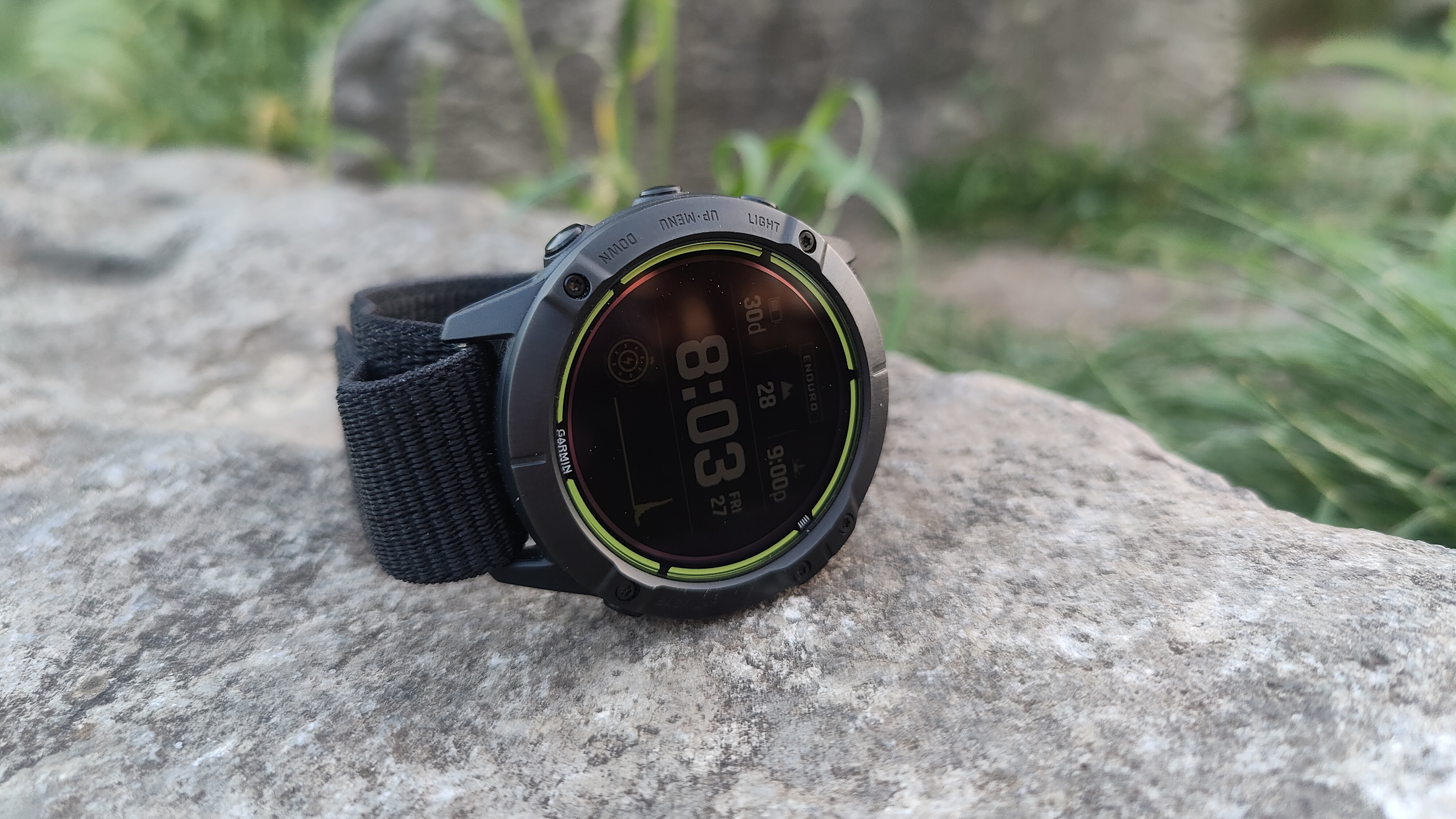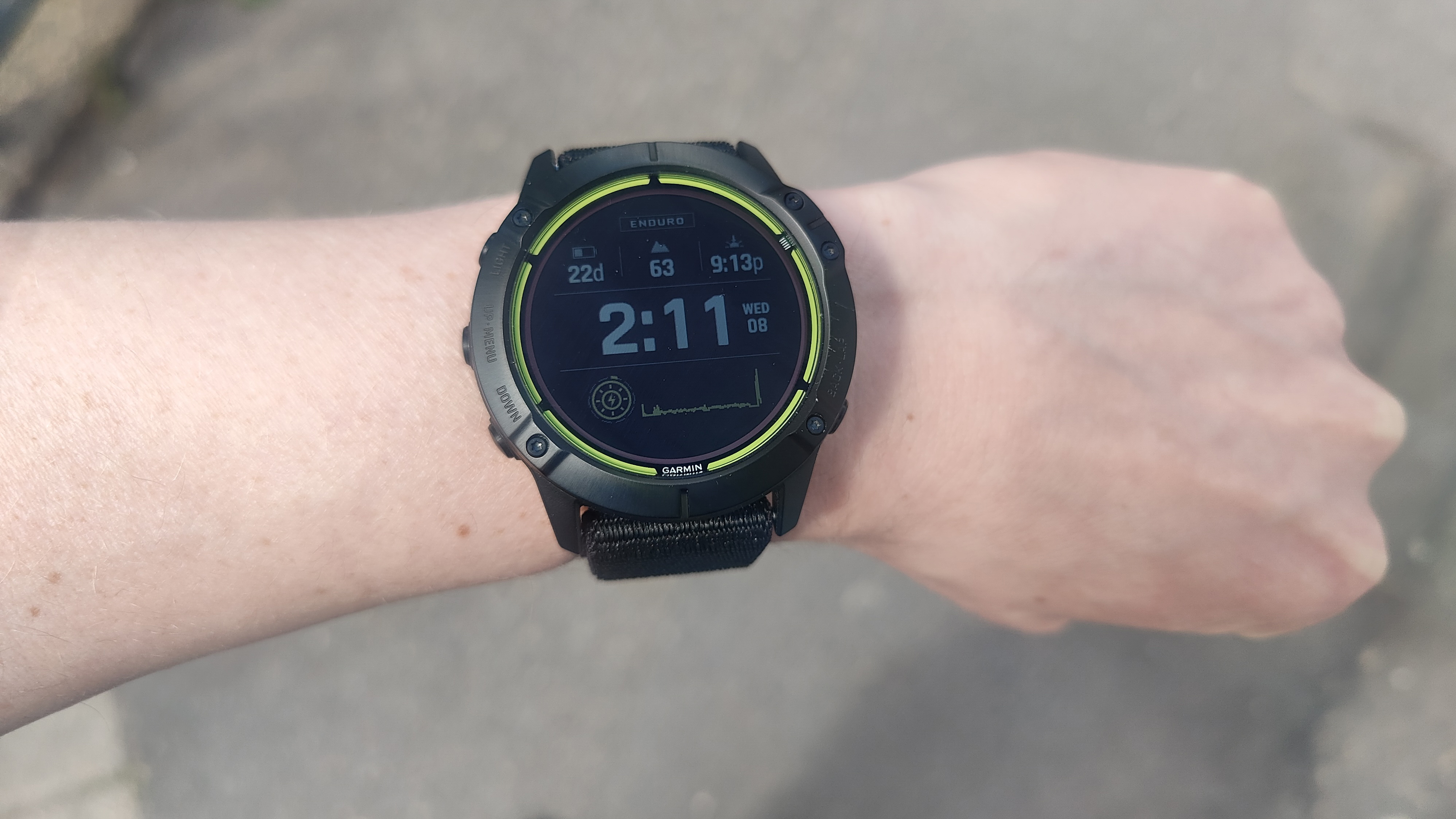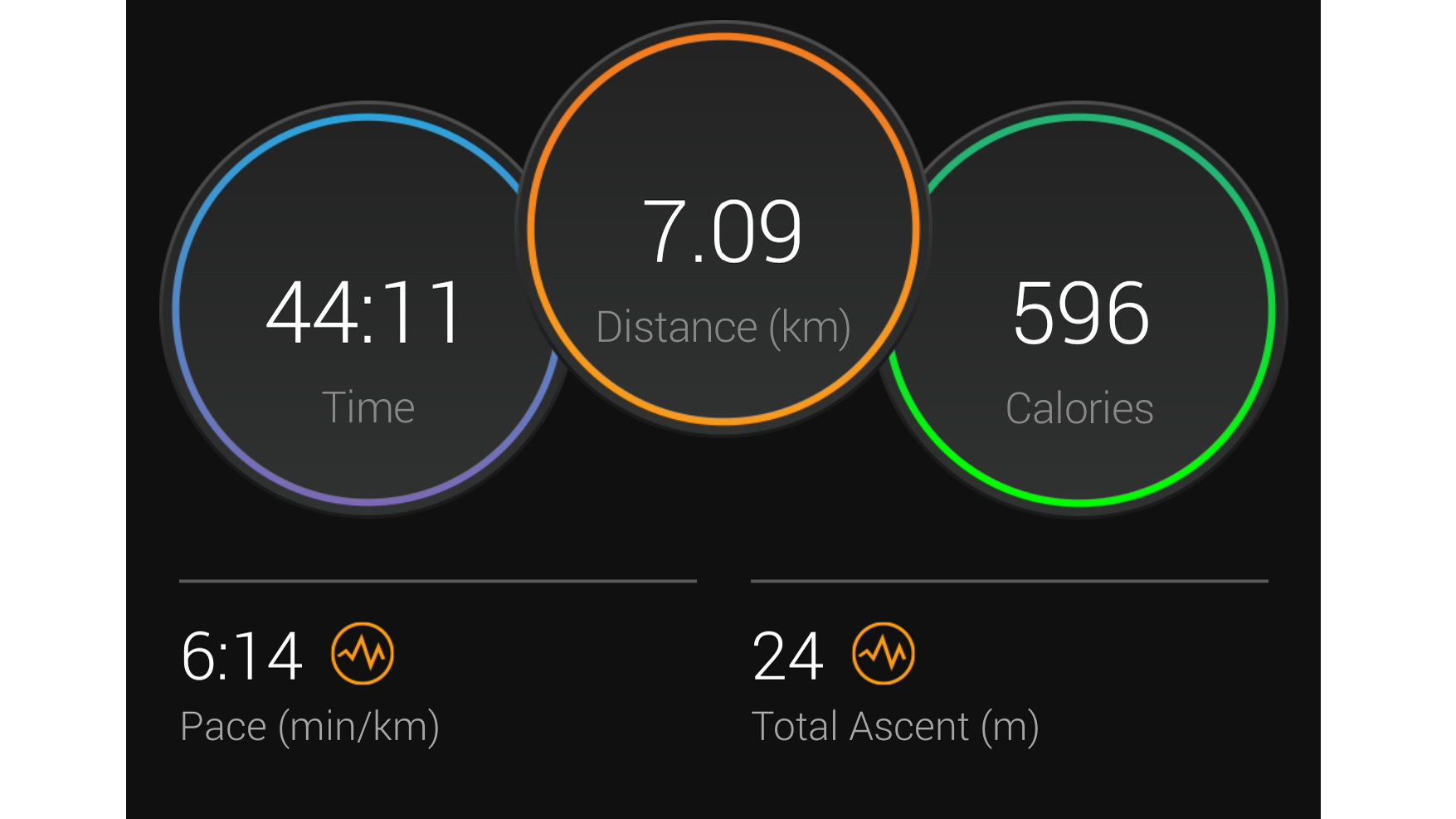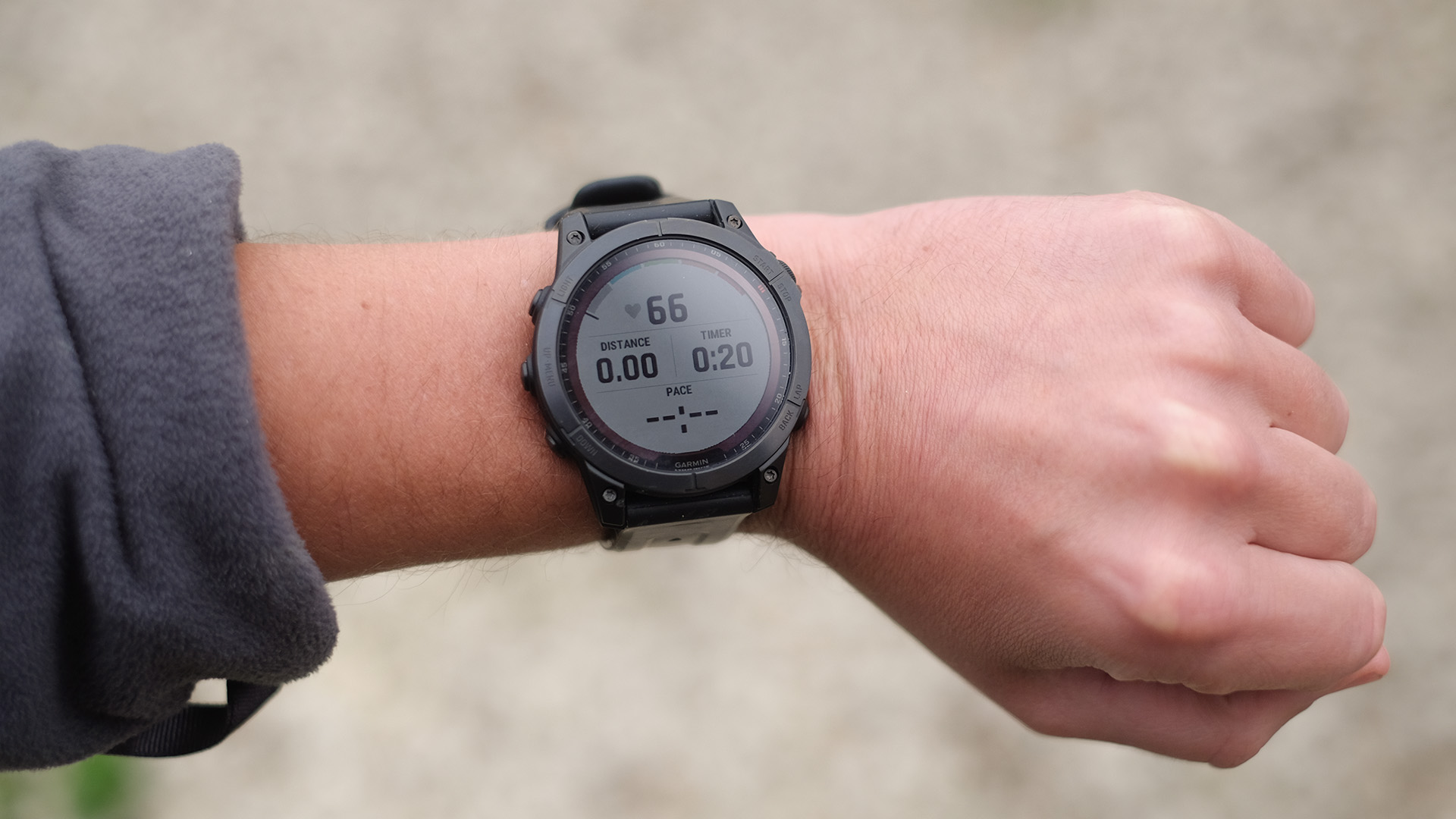Live Science Verdict
The Garmin Enduro is a perfect fitness watch for trail running and other outdoor adventures, with battery life for days – but if you’re not big on the great outdoors, it may not be suitable for you.
Pros
- +
Best battery life on a fitness watch yet
- +
Garmin’s full suite of GPS trail features
- +
Rugged-and-durable design
Cons
- -
No onboard music
- -
Multisport capabilities are not intuitive
Why you can trust Live Science
We’ve gone hands-on with the extra-durable premium-grade Garmin Enduro solar-powered trail running watch to test its design and performance and to highlight its features. We can confidently say that if you’re after a rugged trail-running or endurance sports watch, with battery life for days, this is the one for you.
Battery life: Up to 50 days in smartwatch mode
GPS availability: constant connectivity
Water resistance: 10ATM
Display: 1.4in screen with 280px x 280px
Materials: Power glass screen, stainless steel/DLC-coated titanium bezel, fiber-reinforced polymer case
Solar charging: Yes
Connectivity: Bluetooth, ANT
Garmin is a highly reputable manufacturer of some of the best fitness trackers and fitness watches, and thanks to their advanced GPS features, more than one trail-runner has placed their wellbeing in the hands of a Garmin during a ultra-run or triathlon over the years.
While this model doesn't quite make it to the top of our round-up of the best Garmin watches, it still earned a place low down in the list. Here's what we made of it, after testing it out for several weeks.
Price and release date
The Garmin Enduro was released in February 2021. It is currently priced at $799.99 in the US and £649.99 in the UK.
Design and display

The design of the watch is similar to the Fenix 7. Its 51mm x 51mm x 14.9 mm casing makes it a chunky watch, especially for small wrists, but it’s light, at only 61g for the DLC-coated titanium option and 71g for the stainless steel version.
We tested the DLC-coated model. Combined with the power glass, the watch’s 10ATM water resistance and its incredible battery life, you’ll hardly ever need to take it off, even to charge it. The strap it is supplied with is a simple fabric Velcro band that won’t win any style awards, but the Garmin Quickfit straps are compatible if you want to change it.
The case contains five buttons including one metal 'master' button to start and stop exercises, acting as the 'ok' button. The other four are simple plastic, one activating the backlight, two buttons for “up” and “down” and a “back” button that doubles up as a 'lap' function to set a baseline for your times. In general, we liked the design: it’s simple to use and easy to scroll through stats, select your workouts, and pause and set lap times on the run.
Get the world’s most fascinating discoveries delivered straight to your inbox.
The design of the Garmin operating system is similarly ergonomic. It’s so full of functions that selecting your home screen and viewing your stats can be a laborious process. However, once you’ve spent a few days getting used to the watch, it’s easy to scroll through and access weather data, steps, historic heart rate, a compass, sunrise/sunset and more at the touch of a down button.
Features

The Enduro is stuffed with features. The sports profiles alone feature many different kinds of swimming, running, cycling, strength, yoga and multipart activities, although the endurance sports get the lion’s share of the watch’s workout metrics.
The Enduro features a Pulse Oximeter tracker to monitor your recovery, VO2 max, stress tracking and sleep tracking. The watch packages these into a Body Battery score, similar to the Polar Vantage’s Nightly Recharge. This statistic learns from your previous training records and is designed to detect when you should be training, and when you should be taking it easy.
This is in addition to the litany of other health metrics that comes as standard with every fitness watch, such as constant heart rate monitoring via its Garmin Elevate tech, and skin temperature detection. The watch will also alert you if your heart rate is irregular.
As befits any high-end adventure watch, its GPS functions are good: the display offers positioning at any point in your workout, along with a TracBack feature that allows you to retrace your steps, an essential for trail runs. Combined with the in-built compass and gyroscope, the GPS will offer an arrow dictating your position and a red line to follow.
At the end of each run, cycle or swim, you’ll be able to see a small map of your route displayed on your watch, with the option to save it as a regular route. However, there’s no topography, as the map is flat – although the watch will read your elevation and descent statistics. The solar battery technology means the watch will recharge itself on your adventures, extending its battery life to the frankly ridiculous times listed above. 50 days in smartwatch mode, and up to a year on 'battery saver' mode with solar top-up. During our testing period we never had to charge the watch after setup, completing four hours of workouts over the course of a week and barely making a dent in the battery life.

One feature we would have loved to have seen, but the Enduro sadly lacks, is in-built stored music capability. The watch can act as a remote to control music or other audio from your phone, but there’s no storing music on the watch natively. We love to run with podcasts, so this meant resorting to a chest strap and bringing our phone with us. If you’re trying to go for minimal equipment for a race, you’ll need to carry your phone if you want to work out with a soundtrack. This feels like a feature stripped out to make space for the enormous battery life.
Performance
We tested the Garmin Enduro’s features over a week, completing several different runs and one strength workout. We loved the features of the Enduro during the run: the level of depth we got in the metrics was impressive, with elevation reports, VO2 max, and more, accessible during the run, not just in the post-run report.
However, on our first try with the watch, we had auto-pause on, which is designed to pause your workout automatically when you stop. This function is theoretically ideal for a busy city run, which requires you to stop at junctions and crossings. However, the watch was over-sensitive, pausing during small speed changes, and we quickly turned that setting off.
After that, the watch was a breeze to operate, the five-button function – with easy-to-read metrics thanks to the always-on functionality – and the GPS with TracBack features allowing us to retrace our steps accurately. We tested the watch by running with it and also an everyday watch, the Polar Vantage V2. We also had UnderArmour’s MayMyRun running on our phone at the same time.
Aside from a minute’s difference in the times, accountable for the fact that we had to spend a few seconds turning each watch and app on and off one after the other, all three yielded similar results. The Polar Vantage V2 matched the Garmin Enduro to 0.04 of a kilometer, and there was just one calorie difference between the two watches’ calorie counts. MapMyRun yielded similar results, so we were satisfied as to the watch’s accuracy on a run. If anything, Garmin’s impressive GPS credentials probably make it the most accurate out of the three.

Unfortunately, the same can’t be said for gym workouts. The Enduro’s Strength profile uses the watch’s gyroscope to count your reps, but it’s more accurate on some exercise than others: It counted bench press reps easily enough, but when overhead presses were tried, the watch struggled: it counted at least three extra reps, at least one or two coming from the 'clean' necessary to bring the barbell up to the shoulders and lower it back down safely. You can manually adjust your rep score for each set with the 'up' and 'down' buttons on the watch, but by that time you may as well have written it down in a notebook.
Verdict
The Garmin Enduro is a phenomenal watch tailor-made for trail-runners and ultra-marathons, with Garmin’s full suite of advanced GPS features and its long solar battery life ensuring you’ll never get lost, even if you’re out for a full week of adventuring. It’s got a great design and more endurance tools than you’ll be able to get your head around in a month, never mind the week we tried the watch.
It’s not a perfect watch: it doesn’t hold its own music, and although it’s got plenty of multisport functionality, it’s not designed for it. It’s an incredible tool, but a specialized one and, at more than $600, if you’re looking for an all-round fitness watch for everyday use rather than a dedicated endurance tracker, you’d be better off spending less money and opting for one of the best fitness watches.
Alternatives

Looking for the best Garmin watch out there? The Garmin Fenix 7 (above) is the top model in our books, thanks to its encyclopaedic feature set and decent battery life. It's expensive and a little bulky, but if you want something that can keep up with your outdoor adventures, then this is the best option for you.
On the opposite end of the scale, the simple Fitbit Charge 5 is a fraction of any Garmin watch and tops our list of the best Fitbits. While it might not have the same suite of features found in a Garmin, it can accurately track steps, measure your heart beat and has a sleek, low-profile design.
Matt Evans is the current fitness editor over at our sister site, TechRadar. Armed with a Master’s Degree in journalism from Cardiff University, Matt started his digital journalism career at Men’s Health and stayed on for over two years, where he earned his stripes in health and fitness reporting. Since then, his byline has appeared in a wide variety of publications and sites including Runner’s World, Women’s Health, Men’s Fitness, and LiveScience on everything from exercise, to nutrition, to mental health, alongside covering extreme sports for Red Bull.
Stretching is Matt’s top fitness tip. He originally discovered exercise through martial arts, holding a black belt in Karate, and trained for many years in kickboxing. During COVID he also fell in love with yoga, as it combined martial-arts style stretching with a bit of personal space.
When he’s not training or writing about health and fitness, he can be found reading doorstop-thick fantasy books with lots of fictional maps in them.


